Deadly virus warning: Bug wreaking havoc during summer vacations
Americans are being warned about a potentially deadly virus spread through mosquito bites that is becoming increasingly prevalent in the US.
Health officials say rising temperatures across the country mean infections will only increase and Americans should take steps to protect themselves from bites, which can be fatal within a week.
The CDC says the U.S. has seen a “higher-than-expected” number of dengue infections this year, up 1,000 from all of 2023.
More than 5,300 people have died from the infection worldwide, mostly in tourist hotspots such as Brazil., Mexico and Costa Rica, although Officials warn that cases are also rising in the US.
Above you can see the number of patients who tested positive for dengue despite not traveling outside the United States
The CDC warned last week that many infections, identified in 38 states, were linked to travelers returning to the U.S. from countries where the disease is spreading rapidly.
However, at least eight local cases have been identified within the states.
In Florida, there are about 200 cases, at least six of which have been locally transmitted, in people who have not recently traveled.
There is currently an outbreak in Puerto Rico, with around 1,500 infections. A state of emergency was declared in the US territory in March.
Massachusetts and New York also have the highest case counts in the country, at 50 and 134, respectively.
Dengue fever cannot be transmitted from person to person. It is transmitted through bites from infected mosquitoes, which carry the virus into a person’s bloodstream.
To contract the disease locally, the mosquito population in the area must have contracted the virus. This usually occurs through biting someone who has recently returned to the US from abroad.
It is also possible that infected mosquitoes migrated to the area or arrived by boat or plane.

Dengue is a potentially deadly virus transmitted to humans by infected mosquitoes and was historically known as ‘breakbone fever’
You can get tested to see if you have dengue, but there is no known cure. Doctors can only ‘support’ patients by prescribing medications to control symptoms.
About one in four people infected with dengue fever will show symptoms. These include pain in and around the eyes, muscle and joint pain, nausea and vomiting, and a skin rash.
Symptoms typically occur two weeks after the bite of an infected mosquito and can last two to seven days.
In the United States, a dengue vaccine is recommended for children between the ages of nine and 16 who have previously had a dengue infection and live in an area where dengue is more common.
If a patient develops severe dengue fever, which can happen within hours, it is considered a medical emergency and the patient should be hospitalized.
According to the CDC, in severe cases, people can experience uncontrolled bleeding, dangerously low blood pressure, organ failure and death.
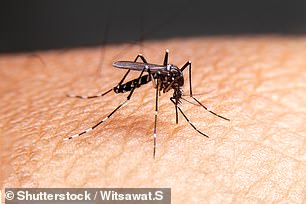
Dengue fever is not contagious and is transmitted by the Aedes aegypti mosquito
About one in twenty people infected with the virus develops severe dengue, with symptoms including abdominal pain, vomiting blood or blood in the stool, and extreme fatigue or restlessness.
According to the NIH, the mortality rate from severe dengue can reach more than 20 percent without proper treatment, especially among vulnerable groups such as children.
Of the dengue cases recorded in the U.S. this year, 745 were travelers — people who tested positive after recently returning from abroad. That’s “higher than expected” for this time of year.
Dengue fever is endemic in many countries around the world. Countries in South America, Asia and Africa tend to report higher numbers of cases.
The CDC has not disclosed which countries people are returning from, but Brazil has had the largest outbreak so far this year: 7.8 million suspected cases of dengue.
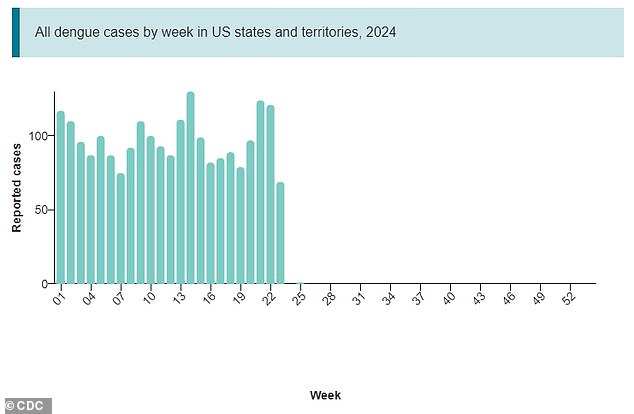
Above you can see the weekly number of dengue fever cases in the US

The above shows estimated cases of dengue fever in countries around the world
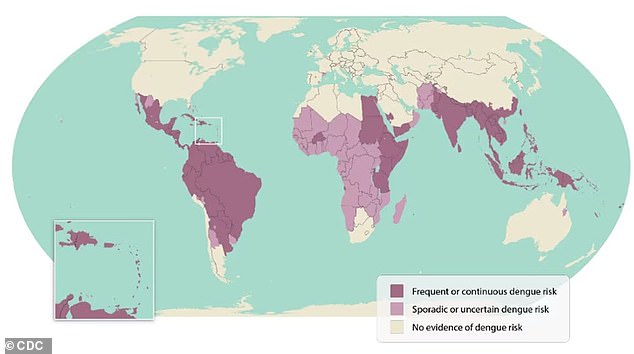
Above is a world map showing areas at risk for dengue fever. Public health officials are now warning that there is an increased risk of dengue fever in the United States
Large outbreaks have also been recorded in Argentina, with 505,000 cases, and in Paraguay with 282,000 cases. More cases have been reported in 90 countries across six continents.
Experts attribute the global increase in dengue to rising temperatures, increasingly violent storms bringing large amounts of rain and flooding, and increased international travel.
Dr. Marty Makary, a physician at Johns Hopkins University in Maryland, told Because the disease is spread through mosquito bites, people should take every step to limit their exposure to the disease and the risk of bites.
This can include wearing loose-fitting shirts and pants with long sleeves, or clothing treated with insecticides. You can also combat mosquitoes inside and outside your home and use insect repellent.
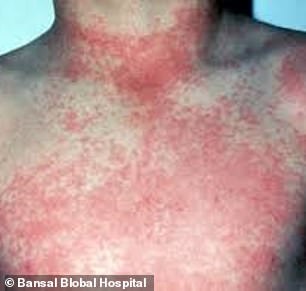
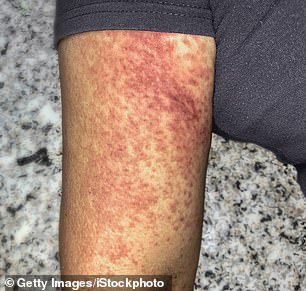
The above photos show symptoms of dengue rash. About one in four people who are infected will have symptoms of the virus, including a rash
Mosquito populations thrive in stagnant water, so it is important to prevent and control areas that could serve as breeding grounds for mosquitoes.
Dr. Makary added that mosquito protection is especially important in the southern states, where temperatures are higher.
He said: ‘It is spread by mosquitoes and that is a good reminder to try to limit mosquito bites as much as possible, especially in the southern United States where this is more common.’
The rise in dengue comes as authorities worry about two other mosquito-borne diseases: malaria and West Nile virus.
The Florida Department of Health issued a mosquito-borne disease advisory last week after four cases of locally acquired malaria were identified in an area along the state’s west coast. All have been treated and recovered.
Like dengue, malaria is often contracted abroad. In the US, there are about 2,000 cases per year.
Symptoms include fever, flu-like illness, muscle aches, vomiting and diarrhea, and chills. If not treated promptly, it can lead to kidney failure, seizures, and coma.
Another mosquito-borne disease that health experts are warning about is West Nile virus. This virus is most common in the U.S., with an average of 2,200 cases per year.
About 20 percent of those infected will show symptoms, including fever and flu-like illness. Less than one percent will progress to a severe infection of West Nile neuroinvasive disease, which can be fatal.
